What is Cash? Definition, Origin and History
Trade has been happening ever since ancient times in this world. People exchanged goods such as clothes, gems, gold, spices, food grains etc, within a country and to other countries as well. Even live stocks like horses were traded between the countries.
As the years passed by, traders were always looking for new ways to ease the trade business. They founded new methods with the technology
available at that time.

Once such finding was 'Cash', that made the trade business very easy. Cash was a legal tender that was issues by governments at that time. So, if a trader wants to sell his good and doesn't want to exchange it for another goods - he can easily exchange it for Cash.
Later he can use the cash to buy the goods, which he is in need. By the origin of Cash, trade flourished and even common man was able to do trading business. Cash is a English word used by British since 1800 AD. In this article, I will explain the meaning , origin and History of the English word Cash.
Lets now look into the details of the English word 'Cash', its meaning, origin and history.
What is Cash?
Cash is defined as a legal tender (money) in physical form; such as coins and currency notes - that are issued by Central bank of each country. It's guaranteed by Governor of the Central bank and can be used to exchange for goods and services.
What is Cash word origin?
From the latest research done by Mannar Mannan in 2020, the Cash word origin is from a pure Tamil word "Kaasu"(Coin) in the period between 16th to 17th century, during British and other Europeans rule in Tamil Nadu, India.
In the year 1678 AD , for the first time - the British modified the Tamil word 'Kaasu' into an English word 'Cash'; used it for their coins and released it from Saint George Fort Chennai. This coin was hand minted. The proof for the same, is shared in this article.
During the same period (16th to 17th century) of other Europeans rule in Tamil Nadu - Danish derived the name 'KAS/CAS' from 'Kaasu' , French derived 'Cache' from 'Kaasu', while Dutch & English derived the word 'Cash' from 'Kaasu'. All of the European languages derived their word for 'cash' from pure Tamil word 'Kaasu'
New research on the English word 'Cash' in year 2020
This Article about the English word 'Cash' is a research work and is independent of other researchers work, done earlier to the year 2020. I have done this research, since the previous research work by other researchers, about the origin of the word 'cash' was incomplete and baseless. I will prove with evidence in this article, that the word cash is derived from pure Tamil word 'Kaasu'.
What English dictionaries say about the History of the word Cash?
English Dictionary says, that the English word 'Cash' derives from the middle French word ‘Caisse’ (Money Box) which derives from the Old Italian word ‘Cassa’ which derives ultimately from the Latin word ‘Cupsa’ (Box).
Cupsa(Latin) => Cassa (Italian) => Caisse (French) => Cash (English).
According to me, the above derivation is not meaningful and is incomplete. Its a story and not History.
What is the latest research findings about Origin & History of the word 'Cash'?
According to our latest research in year 2020 - the origin and history of the English word 'Cash' was from pure Tamil word 'Kaasu' (“காசு”). It was called as KAS/CAS in Danish, Cache in French.
Kaasu (Tamil “காசு” ) => KAS/CAS (Danish) => Cache (French) => Cash (English & Dutch).
What English literature researchers say about history of the word 'Cash'?
Cash is one of the widely used words in English. It is considered as an English word itself but the root word for Cash doesn’t originate from English. The word Cash was not found to be in use by English until 18th century.
So, the English literature Researchers started to find the roots of the word Cash.
French Origin
In general, most of the English words have their roots from Latin or French. So, they looked upon French origin, and found a word 'Cassie' which means 'money box'. Cassie was in use from 14th to 17th century and it was not in use by French until 14th century. Next, they started searching on how did French obtain this word.
Latin Origin
French got the word 'Cassie' from Italian word 'Cassa', which was finally derived from Latin origin word 'Cupsa' meaning Box.
So, the researchers concluded from both these findings that, the word Cash originated from French; and French obtained it from Latin. They also recorded that the English word for box – Case, has evolved into the word Cash, which means coin.
On contrary, these words were not found to be used by the French or Italian widely. So, it's not believable that this word has influenced the other language speakers, while it was not even familiar with the native speakers.
But this theory is made as an acceptable one, till date.
Cash from Asian Origin
Then few researchers claimed that; only after the arrival of English people at Asia, this word has been included in English - so, it must have its roots from Asia. As usual China claimed that, it belongs to Chinese. There is a Chinese word which has similar pronunciation as Cash but the meaning doesn’t refer to coin, money or money box. It referred to a paper which was used to wrap money, using this illustration, China raised its claim towards the word Cash.
The word cash is found in Chinese coins but it's found to be used only after AD 1900. So, it can be understood that Chinese got the word Cash from English. So, it’s not possible for its entry from Chinese to English. If Chinese already have a word similar to cash, then what was the need to use the word cash in English in their coins?
Cash from Indian Origin
After China, researchers reached India. The Indian Archaeological and Numismatics department always prioritize North Indians. They claimed that the ancient north Indian word 'karshapana' (refers to coin), is the root word for Cash. They didn't have any proof to claim when and how did the word karshpana turned into cash.
So, the claims raised by the all languages like Latin, French, Chinese, Sanskrit is found to be incomplete and doesn't have an proof.
Then, which is true?
There was one more option, but they didn't do it. Whenever you search for origin of a word in other languages, you always need to look into the oldest Language in the world, which I believe; they didn't do. When Tamil is the oldest language in the world, the researchers should have looked into it for the origin of the word cash.
Tamil word Kaasu
The English word Cash originated from the pure Tamil word 'Kaasu' (காசு).
If you ask me to show - at least one proof that; the word cash is a Tamil word? Not just one, there are more than ten proofs, I'll show them in detail.
First, you need to know the origin of the word Tamil word 'Kaasu'.
Origin of Tamil word Kaasu
As Tamil is the first language in the World, the word 'Kaasu' is found at least ten times in the Tamil literatures which are about 2000 years old.
For example, quotes containing the word 'Kaasu' (காசு), from 4 ancient Tamil literatures is shown here. (Can be understood with the help of those who can read Tamil).
Likewise, the word 'Kaasu' is been used many times in ancient Tamil literatures.
Though the word 'Kaasu' was used to refer money in later Tamil, but in ancient literatures it referred to the ornamental balls. While considering the meaning of word 'Kaasu' in ancient Tamil literatures, it usually referred to the balls of ornaments - that was worn by women around waist and the anklets worn by children.
'Kurunthogai' one of the ancient Tamil literatures describes the structure of 'Kaasu' as, a golden ball which has a new thread inserted into it, looks as if a parrot pecking a neem fruit.
While describing 'Kaasu'; the ancient Tamil literatures metaphorizes them using neem fruit, gooseberry, Manila Tamarind, Gmelina asiatica and the buds of Indian Laburnum.
From this we can firmly conclude that the 'Kaasu' was spherical in shape with a hole in centre.
Apart from gold, marbles were also used to make 'Kaasu'. Excerpts from one of the ancient Tamil literatures 'Agananooru' describes kaasu as “A marble ball with hole”
So finally, we can understand that during ancient times the word 'Kaasu' referred to balls of ornaments.
From when, did the word which referred to spherical balls were used to refer flat coins? Let’s see that too...
While Tamils had trade relationships with Romans, they got lots of Roman gold coins. From then instead of using golden balls, They started using intertwined golden coins in ornaments. Since then, the metonym 'Kaasu' which referred to ball was also used to refer coins. During later centuries, the usage of the word Kaasu made us forget the fact that - it was once used to refer to the balls of ornaments.
There is a proof found in literatures, which says Tamils used the word, Kaasu.
Sekkizhar who lived during 12th century has mentioned the word 'Kaasu' in his Periyapuranam, while describing an incident that took place during 7th century.
In that, a scene about Appar and Thirugynana sambandhar's travel to 'Thiruveezhimalai' during famine period is described. There they pray to God for money in a Shiva temple and they were blessed with Thanga Kaasu (Gold coin).
Periyapuranam says that the coins which both of them got were not similar, Appar's coin was flawless while Gynanasambandhar's was found to have a cut.
During Roman period, on the coins reaching India, the ones with correct proportion of Gold will be allowed for usage while the rest would be cut with Chisel by Goldsmith. These coins can't be exchanged at shops and they will be valued only for the metal.
“Lord Siva gave Sambandhar a coin, hit with chisel and flawless one to Appar”, says Periyapuranam.
In the same poem Sekizhar explains us, why such partiality was shown.
Gynanasambandhar effortlessly attained enlightenment with God's grace, he is like God's son. But Appar gained the grace of God through charity.
Even though being God's son, got little as he reached the position without much efforts and the one who worked hard got more, thus says Periyapuranam.
Likewise, there are lot of evidences for prevalence of the word 'Kaasu', among people of medieval period.
Till Now we have seen, what was the meaning of the Tamil word 'Kaasu' earlier and how it turned out to mean coins later.
Now Let's see, how did the Tamil word 'Kaasu' change into an English word 'Cash'.
How Kaasu became Cash?
In 1620 AD, Danish East India company was established in Tranquebar (Tharangampadi in Tamil) port in Tamil Nadu and made a trading agreement between envoys of the Danish King Christian IV and Raghunatha Nakir, the King of Tanjore, district of Tamil Nadu in India.
Danish East India first minted their coins in the year 1620 without the year mentioned in it. Since they didn't have a name for their coins, and Kaasu was predominantly used by kings and public in Tamil nadu, the Danish East India company took ‘Kaasu’ Tamil name for coins and named their coins as KAS as well as CAS.
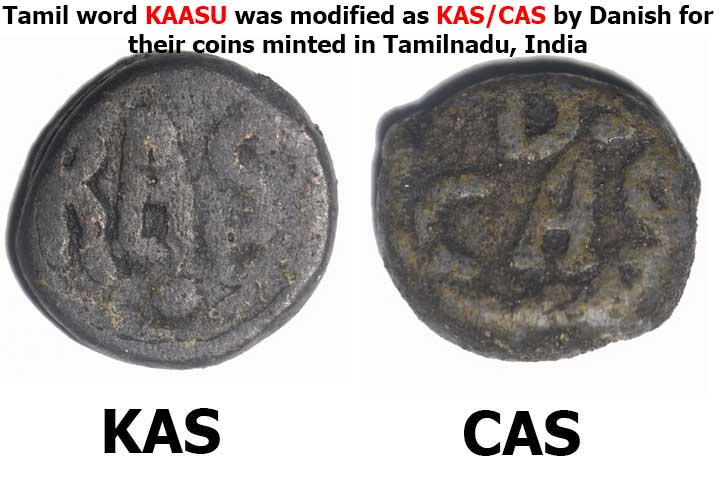
This is the first time in history, the Europeans minted their coins for circulation in India.
If you ask me for proof, here is it from the Danish numismatist.
Mr. Uno Barner Jensen, (Member of - Danish Numismatic Society, Oriental Numismatic Society, Farum og Omegns Møntsamlerforening) is the author of the book
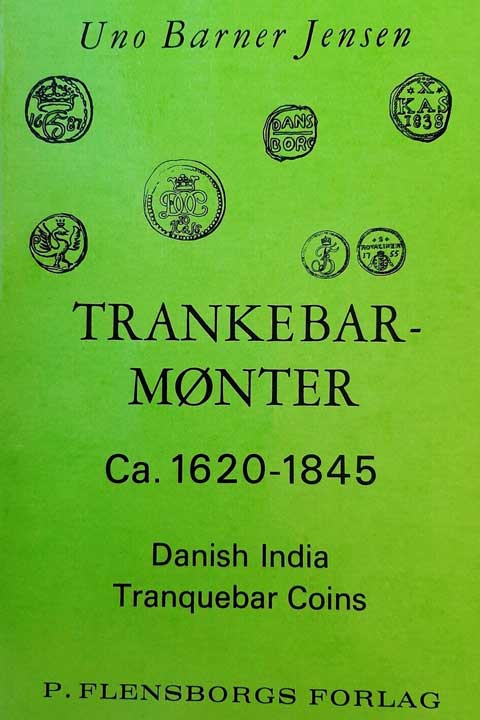
Trankebarmønter ca. 1620 - 1845, Danish India, Tranquebar coins, with drawings of all the types of coins issued by Danish in India.
Since all the coins issued by Danish were made of Lead metal; due to corrosion, most of the coins were lost due to rusting. So, Mr. Uno Barner Jensen couldn't get images of coins but has given the drawings of those coins in his book.
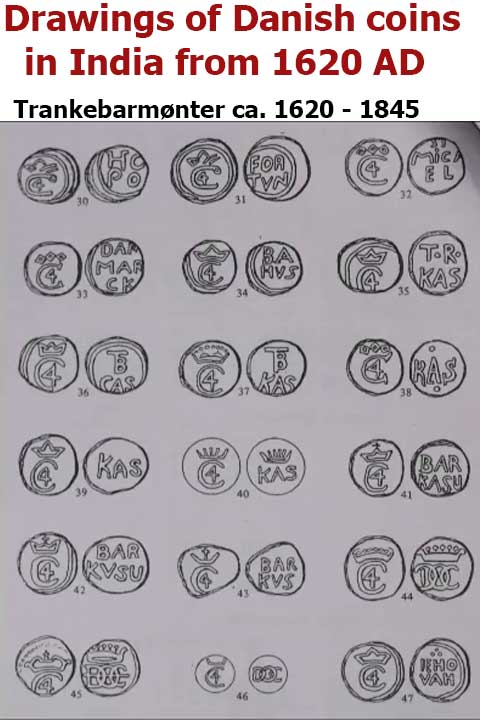
Mr. Mannar Mannan, a numismatist from Tamil Nadu, has a collection of first minted Danish coins in India, and the images are shown below.
The word KAS is mentioned on the front side of the coin and, on the backside of the coin, you can see the letter ‘C’, number 4 and a crown symbol on top of the letter ‘C’. This denotes the Danish King Christian IV, at that time.
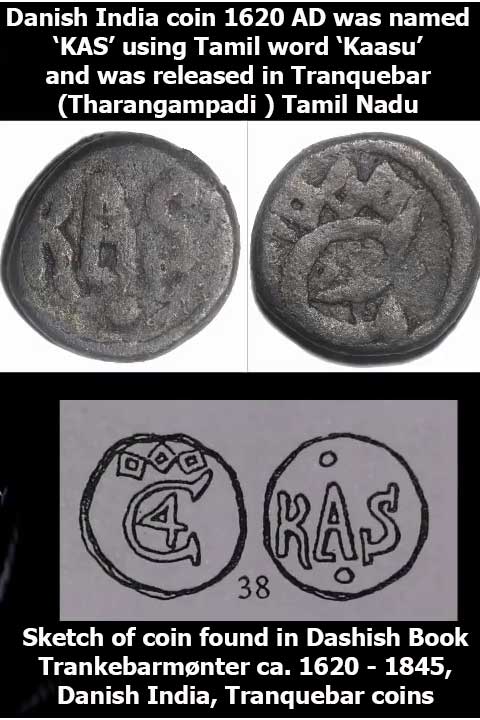
Your next doubt is - this does not have a year mentioned in it, then How can you know the year of minting the coin?
In Trankebarmønter book, Uno Barner Jensen has shown the drawings of the same coin shown in the image and has mentioned - it was minted and released during 1620 by Danish in Tamilnadu.
Later in 1637 AD, Danish East India minted the second coin type, with the year mentioned in the coin; we don't have an image of the coin, and the drawings of the 1637 coin is shown below.
From then on, they minted coins with years such as 1644, 1645 mentioned in it. The Images of the coins are given by Mr. Mannar Mannan and the same can be cross checked with drawings of the same coins found in the Trankebarmønter book.
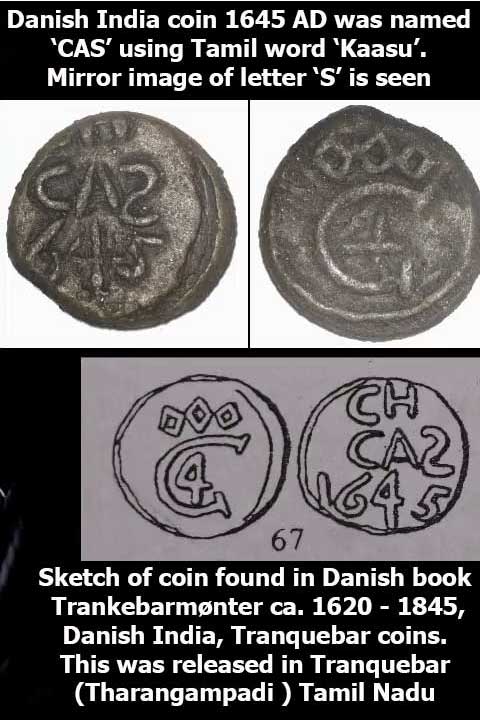
One noticeable change in their 1645 minted coin is the letter ‘S’ in the word CAS, is a mirror image of the letter ‘S’.
From this, we confirm that, from 1620 AD, the word KAS / CAS for coins was taken from the Tamil word Kaasu by the European traders (Danish traders).
When did the British start using the word CASH for their coins?
In 1646 AD Britishers came to Madras (now Chennai) and started establishing their rule from Saint George Fort, their first Mint street was setup in Chennai at the current secretariat of Tamil Nadu, St.George Fort.
The coins for Madras presidency were minted there. Since the coins of Tamil nadu were known as 'Kaasu' by that time, English also adopted the same coin system.
In the year 1678 AD , for the first time - the British modified the Tamil word 'Kaasu' into an English word 'Cash'; used it for their coins and released it from Saint George Fort Chennai. This coin was hand minted.
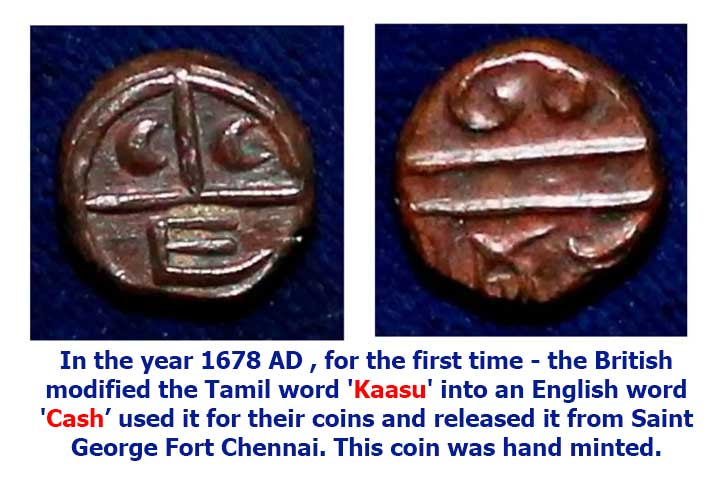
From this we come to know that the word CASH was familiar for the European Union countries and used by the British before 1700 AD.
From AD1803 British start using machine for minting cash coins.
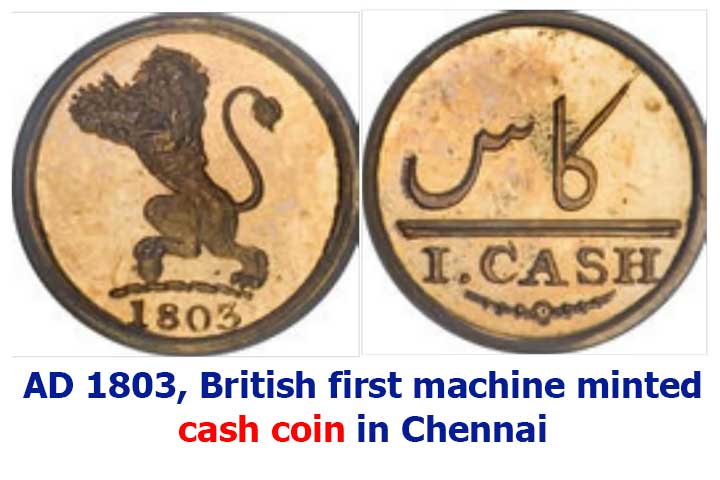
You can ask; why is it told us that the word cash entered into English Language from Tamil? Can't it be the reverse? There is a solid answer for this question
The machine-minted coins introduced after 1803, had their values been mentioned in Tamil letters also.
In front side of that coins, the values were mentioned as - 2 1/2 kaasu (காசு), 5 kaasu (காசு), 20 Kaasu (காசு), 40 Kaasu (காசு).
In coins backside; values were also mentioned in English as 2 1/2 Cash, 5 cash, 10 cash, 20 cash.
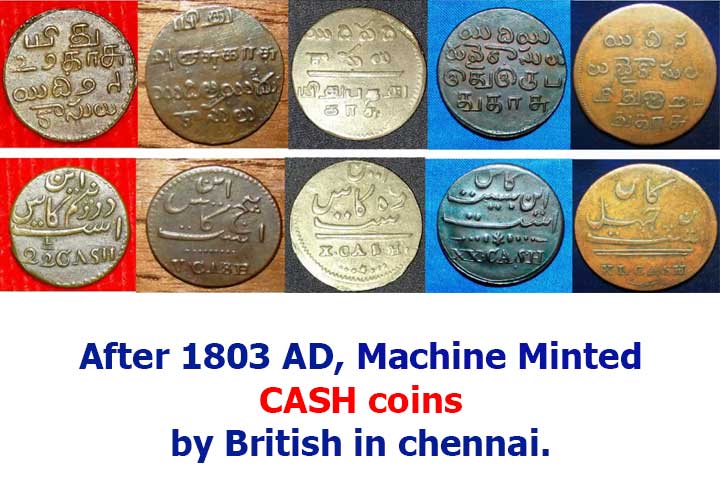
This is similar to a Dictionary where, below a Tamil word, the synonyms would be mentioned in English.
This one illustration is enough to prove us that the word Cash originates from the Tamil word Kaasu.
So, was it only the English, who used the word Kaasu?
No. Other European rulers of Tamil Nadu also used this word. We have already seen that in AD 1620 Danish traders took 'Kaasu' from Tamil and used it for their coins like 1 Kas, 4 Kas, 10 Kas.
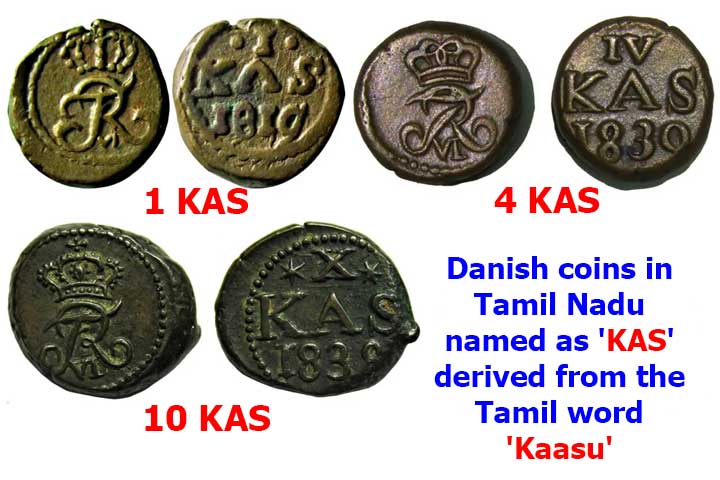
The British started using the word 'cash' globally only after 1800 AD, for example the word 'CASH CROP’ ( Tea, coffee, Cotton etc ) was first used by the British in the year 1831. Earlier to that, there is no evidence for usage of the word 'CASH crop' in British history.
From this we confirm that; the English word CASH was taken from the Tamil word ‘Kaasu’
But dictionary says, that English word ‘Cash’ was taken from the French word ‘Caisse’
Caisse (French) => Cash (English). This is wrong.
Caisse means ‘Money Box’ in French, Caisse is not the word used for cash in French.
Then, what word did the French use for cash?
The French called their cash as ‘Cache’.
Where did the French take the word ‘Cache’ from?
Again the French word ‘Cache’ was taken from the Tamil word ‘Kaasu’
Can you prove that the French word ‘Cache’ was taken from the Tamil word Kaasu?
Yes. From the history of French rule in Tamilnadu, I'll prove that - the French got the word ‘Cache’ from the Tamil word ‘Kaasu’.
History of French in Tamil Nadu, India
Below are the list of French trading companies established in India
- From (1664–1719), French East India Company "Compagnie Française des Indes Orientales"
- From (1719–1720) Company of the Indies "Compagnie des Indes" ,
- From (1720–1789) French Company of the Indies "Compagnie Française des Indes"
By an agreement in 1739 AD, the French started ruling Karaikal. In 1740, French released their first coin in Karaikal, with Puducherry (புதுச்சேரி) mentioned on one side of the coin and Karaikkal (காரைக்கால்) mentioned on the other side. They named this coin as ‘காசு‘ ( Kaasu) in Tamil and ‘Cache’ in French records.
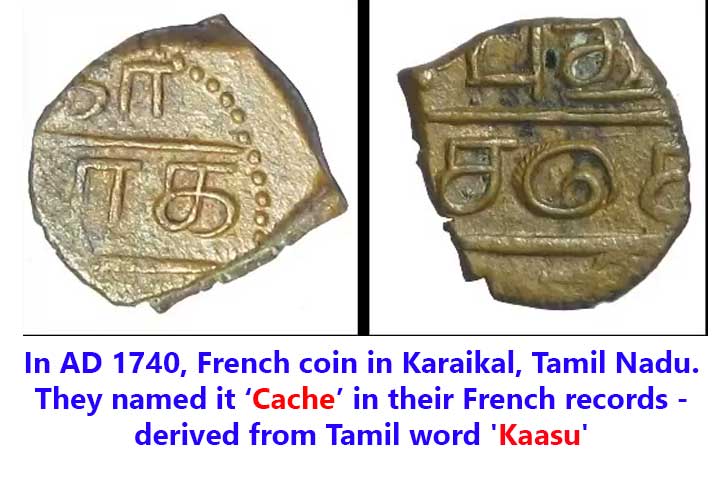
From the years (1648 - 1740) we can see that the Tamil name ‘Kaasu’ was called ‘Cash’ by the British and ‘Cache’ by the French.
From this, I prove that ‘Caisse’ is not related to the word ‘Cash’ as mentioned in the English dictionary. Because the French used the word ‘Cache’ for cash and not ‘Caisse’.
The details given in the dictionary, that the English word ‘Cash’ was taken from the French word ‘Caisse’ is FALSE.
Is there more evidence that French got the word ‘Cache’ for the Tamil word ‘Kaasu’?
Yes. There is evidence. In order to prove this, you need to know the history of Dutch in Tamil nadu.
History of Dutch in Tamil Nadu
Dutch are people from Holland; and Dutch traders have done trade in India.
In 1658 the Dutch traders started trade in Nagapattinam of Tamil Nadu State.
In 1693, the Dutch traders captured Pondicherry from French rulers; and the Dutch ruled Pondicherry till 1698.
During this period, Dutch traders released their coin in the Tamil name ‘புது காசு’ (Pudhu kaasu) which means ‘New cash’ in English. From this we can understand that; Pondicherry which was ruled by French earlier had released coins in the name of ‘Kaasu’ and then Dutch who became the new ruler of Pondicherry replaced the French coin ‘Kaasu’ with the name (Pudhu Kaasu) meaning New cash.
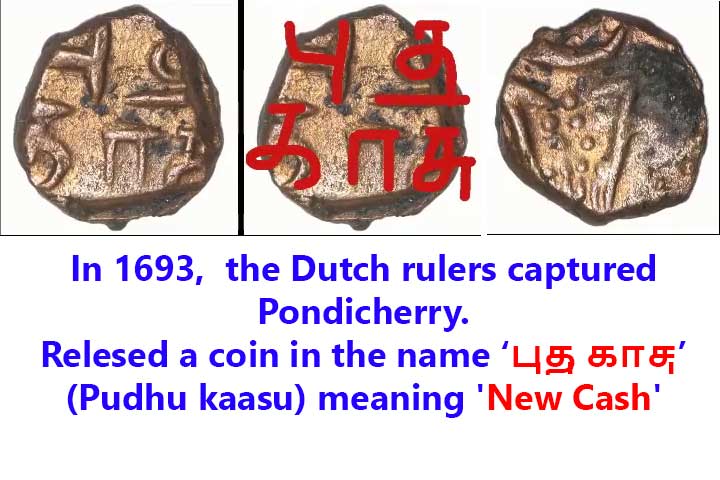
The coin released by the Dutch in Pondicherry had the name ‘புது காசு’ (Pudhu kaasu - New Cash) on the front side and goddess Kaali image on the back side.
Dutch rulers also released coins while ruling Nagapattinam, The image of the coin is shown below.
On one side of the coin, it's minted ‘VOC’ , the symbol of Dutch East India Company and the letter ‘N’ denotes Nagapattinam.
On the other side of the coin ‘நாகப்பட்டினம்’ (Nagapattinam) is minted.
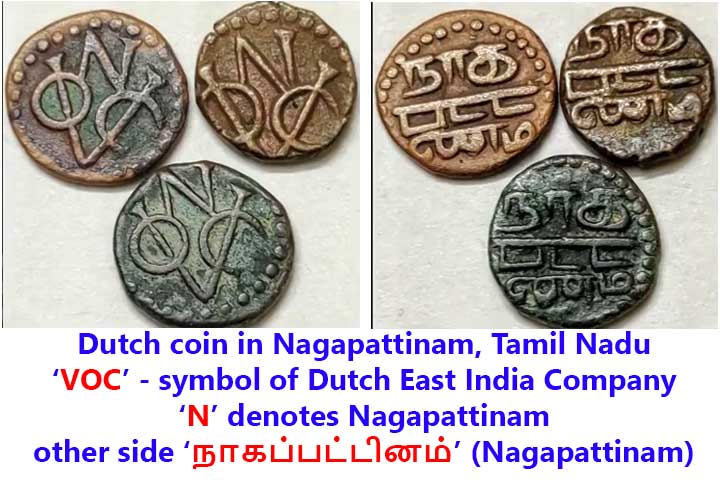
The Dutch named this coin ‘CASH’. In all their documents, they have mentioned the word Cash for this coin.
From this, we can understand that, while Europeans entered Tamilnadu - all the Tamilnadu kings were using the word Kaasu for coins.
Europeans tried to use the same word ‘Kaasu’ for all their coins and that's how they got the below names for their coins.
British called it as Cash
Dutch called it as Cash
French called it as Cache
Danish called it as KAS/CAS
Within a century, the word ‘cash’ became commonly used across Europeans and it's now globally used.
From this we confirm that the word ‘Cash’ was introduced to European Union countries through the Tamil word ‘Kaasu’ from Tamilnadu.
I have proved the Origin and history of the word ‘Cash’ from the Tamil word ‘Kaasu’. But the dictionaries don't have any proof or give any evidence for the origin of the word ‘Cash’ from - French, Italian and Latin.
What I'm surprised with is - when the oldest language Tamil, has given so may finding like Siddha medicine to this world, why didn't the English researchers look into to Tamil for the source of the word 'Cash'.
Final words from Mannar Mannan.
In order to prove this, I have put lots of effort. Because, I learnt the history of Europeans in Tamil Nadu, India. I need to verify all the collected documents and make it a single article by connecting the dots. Collecting the old coins was the most difficult work, the coins were very tiny, so the cost of the camera for taking the picture of the coins was also high.
I have done all this to prove and show the world that, this single English word 'CASH' came from the 'KAASU' - a pure Tamil word. Till now, such facts and evidences were known only to Numismatists like me.
Conclusion
Cash is defined as legal tender (money) in physical form; such as coins and currency notes. According to latest research findings in year 2020; for the origin and history of the word 'Cash', we proved and concluded that; the English word Cash is derived from Tamil word 'Kaasu' - that's been used since 300 BC till now in Tamil Language. British got the name 'Cash' from Tamil word 'Kaasu' while ruling Tamil Nadu, India - during 16th to 17th century.
Tamil desiyam requests you to share this article. So that; people around the Globe will know "The Origin of the English word CASH is from KAASU - a pure Tamil word".
Frequently Asked Questions
Why is cash called cash?
According to latest research done in 2020 by Mannar Mannan, the English word Cash originates from the Tamil word 'Kaasu' (காசு) which means coins in Tamil language. This word was later pronounced as KAS and finally Cash. That's why cash is called as cash.
When was cash introduced?
The word Cash was not found to be in use by English until 18th century. But 'kaasu' the root word of cash is found at least ten times in the Tamil literatures which are about 2000 years old.
Who introduced cash?
Tamils introduced the word 'Kaasu' for coins to the British in 16th century. From then; British used a similar word 'Cash' for their coins. So, I confirm that the word cash was introduced by Tamils.
When did British first use the word Cash for the coins?
In 1678 AD, British first used the word Cash for the coins. They derived the word 'Cash' from Tamil word 'Kaasu' and released their first hand minted coin named as Cash from Saint George Fort Chennai, Tamil Nadu.
What is the relation between the English word Cash, and the Tamil language?
Good research work by Mannar Mannan. Thanks to him, for collecting these data and sharing it to us.
Nice to see this Article about ‘cash word origin’. Finally, Tamil people have started to show interest in their history. Good Work